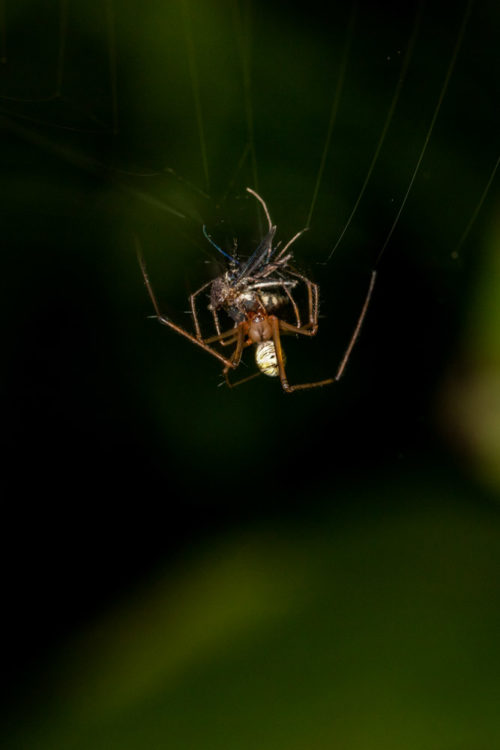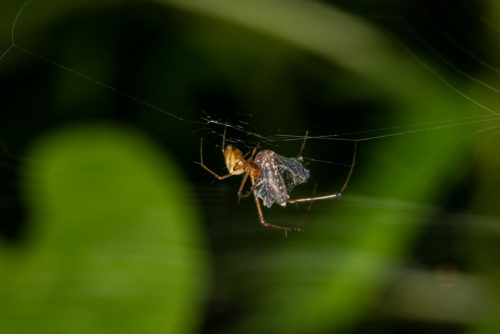
I had found this long clawed orb weaver spider Tylorida striata in my garden on that late evening. This spider builds delicate orb webs with open hubs in shadowed areas of gardens. Since the spider had created the web and waiting for the prey to fall, I thought of stalking the web to see if I can catch the act of capture of the prey itself. This turned out to be a long drawn process over three hours. So I put my Walkstool next to the web and waited. Walkstool is a Swedish invention which is a three-legged stool with telescopic legs. It is very low set stool which is also comfortable to sit and wait for long. I was perched right above the web waiting for a victim to get trapped.

It was getting dark and as usual one of the nuisance all macro photographers have to go through are mosquitoes. They prefer the twilight hours which are also favourable to insect photographers like me. If we use mosquito repellent cream or spray to avoid mosquitoes they will also make the insects which we want to photograph to run away.

Full sleeved shirt and thick pants this fully covering the body is the only option we can use to avoid getting bombarded by these small mosquitoes. Culex is the commonest in my garden and I haver covered about this mosquito in my earlier blog here. These mosquitoes are most troublesome between 5-7PM

It took me 2 hours and over 34 mosquito bites (yes, I actually counted 😉 ) for an opportunity to capture. One of the mosquitoes which were aiming straight at me did not see the web and fell into the trap. What happened next is very fast and blurry. The whole sequence lasted only a few seconds. Before the mosquito realised that it had hit the web and recovered the initial jolt, the spider had pounced on the mosquito and rapidly started spinning a cocoon all around it.

First two shots of mine were blurry (not posted here) as I always keep the lens in manual focus for macro photography and I have to refocus by moving the body of the camera forward and backward to get the right focus. By the time I focused, I saw the spider had spun few strands of silk around the mosquito. It was turning into a cocoon of strong silk strands and poor mosquito who rushed for a hearty blood meal from me became incarcerated food for the spider.

Within a minute whole drama was over and you will see the spider bite the prey, wrap it in silk, wait for it to die, then it begins to eat. As the first step in eating, the spider will literally inject digestive fluid over the prey. Then the prey is chewed with the “jaws” (chelicerae), and the fluid is sucked back into the mouth together with some liquefied “meat” from the prey. The spider repeats this process as often as necessary to digest, and ingest, all but the inedible hard parts. What is discarded afterwards is a small ball of residue.

The webs of spiders are incredibly diverse in structure, and the form of the web depends on the kind and size (age) of the spider. Many spiders weave webs with spaces between the strands that are just right to catch a large juicy insect but allow smaller ‘snack-sized’ meals to fly right through. It takes energy and time for the spider to weave the web, and the more threads per unit area, the greater the expenditure. Would it be worth creating a densely-woven web just to catch small prey? If relying upon small insects in the diet were a good economical practice, then it is likely that the spiders would subscribe to that strategy.

I used Canon EOS 5DS R with Canon EF 100mm f/2.8L Macro IS USM lens fitted with 68mm Kenko extension tube set. This gave me nearly 2:1 magnification. It also cuts down nearly 2 stops of light. This was illuminated by Godox Ving V860c E-TTL Li-ion Camera with LumiQuest SoftBox III.

Tylorida can be identified by their high abdomen which roughly forms a right angled triangle in shape, the right angle is located at the highest point from where short steep side slopes to the front and long steep side slopes to the spinnerets. The ventral side of abdomen forms the hypotenuse. A total of four species of Tylorida are reported from India so far.


One of the Best, I have ever seen in Macros, I believe in 6 feet behind the Cam, who is filled up with creativity mind.
Thanks for wonderful explanation and the blog, which helps with settings to learn the subject too.